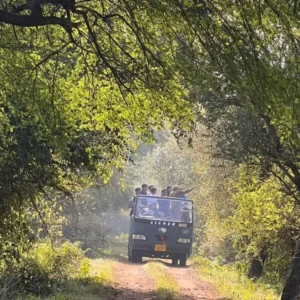The majestic tiger, one of the most iconic and beautiful animals in the world, is facing a severe threat to its survival. With only around 3,900 Bengal tigers left in the wild, tiger conservation has become an urgent global priority. One of the significant tiger reserves in India is the Sariska Tiger Reserve in Rajasthan.
Established in 1978, it is one of the most critical habitats for tigers in India. It spans across 866 sq km and is home to over 25 tigers, along with other endangered species such as leopards, sambars, and wild boars. However, the increasing human population and poaching activities have put the lives of these magnificent creatures at risk.

Tiger conservation in Sariska is a joint effort of the Rajasthan state government, wildlife experts, NGOs, and local communities. Several measures are being taken to protect the tigers and their habitats. One of the significant initiatives is the implementation of a radio-collar tracking system that enables the monitoring of tiger movements and helps in preventing poaching.
Another initiative is the relocation of local communities living in the buffer zone of the reserve. The relocation of these communities helps to reduce the human-tiger conflict and allows for the conservation of the natural habitat of the tigers. The local communities are also being educated on the importance of tiger conservation and the benefits of sustainable tourism.
Sustainable tourism is also a vital component of tiger conservation in Sariska. The Sariska Tiger Reserve offers several eco-tourism activities such as jeep safaris, bird-watching, and trekking. These activities provide an opportunity for tourists to appreciate the beauty of the reserve while generating revenue that is essential for the maintenance of the reserve.

However, it is essential to ensure that tourism activities do not harm the natural habitat of the tigers. Tour operators should follow the guidelines and regulations set by the authorities to prevent any disturbance to the tigers’ natural behaviour. The authorities should also ensure that the number of tourists visiting the reserve is limited to prevent overcrowding.
In addition to sustainable tourism, there are other measures that can be taken to protect the tigers in Sariska. One of them is the strengthening of law enforcement agencies to prevent poaching activities. The poaching of tigers and other endangered species is a significant threat to their survival, and stringent action must be taken against the poachers.
Another measure is the conservation of the tigers’ natural habitat. The authorities must ensure that the forests are protected and that there is no illegal felling of trees or encroachment into the forest area. The authorities must also take measures to control the human population and prevent any further expansion into the reserve area.
It is essential to involve local communities in tiger conservation initiatives. The local communities must be made aware of the importance of tiger conservation and the role they can play in preserving the natural habitat of the tigers. The authorities must work closely with the local communities to address their concerns and to ensure that they are not adversely affected by the conservation measures.

In conclusion, tiger conservation in Sariska is a vital task that requires the collective efforts of the government, wildlife experts, NGOs, and local communities. The measures being taken to protect the tigers and their habitat are essential, but there is still much work to be done. Sustainable tourism, strengthening of law enforcement agencies, conservation of the natural habitat, and involvement of local communities are some of the measures that can be taken to protect the tigers in Sariska. The conservation of tigers is not only important for the survival of the species, but also for the preservation of our natural heritage. We must take urgent action to ensure that these magnificent creatures continue to roam free in their natural habitat.




